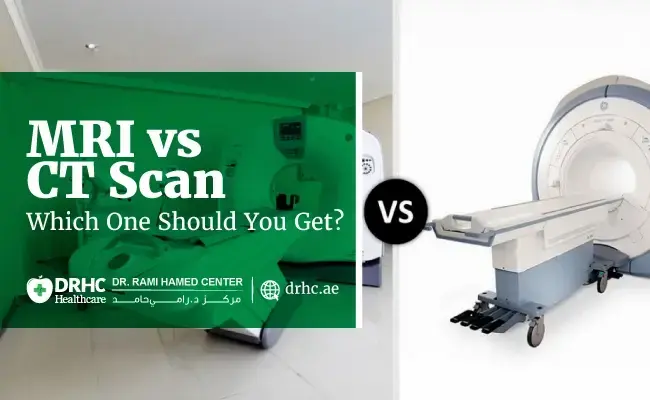
If you’re struggling with persistent back or neck pain, you're not alone. Spinal discomfort—whether in the lower back (lumbar region) or the neck (cervical region)—is one of the most common reasons people in Dubai seek medical attention. When conservative treatments like rest, physiotherapy, or medications don’t provide relief, your doctor may recommend an MRI scan to get a clearer picture of what’s going on inside your spine.
At the Dr. Rami Hamed Center (DRHC) in Dubai, we understand that undergoing medical investigations can raise concerns—especially when it comes to spinal pain and the possibility of surgery. This blog will walk you through the essentials of MRI for spinal pain, the differences between lumbar and cervical MRI scans, what to expect during the procedure, and when it might be the right step for you.
What Is an MRI and Why Is It Used for Spinal Pain?
MRI (Magnetic Resonance Imaging) is a non-invasive imaging technique that uses powerful magnets and radio waves to create detailed pictures of the spine's soft tissues—including nerves, discs, spinal cord, and ligaments. Unlike X-rays or CT scans, which mainly show bones, an MRI gives your doctor a much clearer view of potential sources of pain that aren't visible through other imaging tests.
Common reasons your doctor may order an MRI for spinal pain include:
- Herniated or slipped discs
- Spinal stenosis (narrowing of the spinal canal)
- Nerve compression (pinched nerve)
- Degenerative disc disease
- Tumors or infections affecting the spine
- Unexplained numbness, weakness, or tingling in the limbs
Lumbar MRI vs. Cervical MRI – What’s the Difference?
Understanding the location of your pain helps determine which part of the spine should be examined.
Lumbar MRI – For Lower Back Pain
A lumbar MRI focuses on the lower spine and is typically recommended when you’re experiencing:
- Persistent lower back pain
- Pain radiating down the leg (sciatica)
- Numbness or tingling in the legs or feet
- Difficulty walking or standing upright
- Loss of bladder or bowel control (in severe cases)
This scan helps identify issues such as herniated discs, spinal canal narrowing, or nerve root compression in the lumbar region.
Cervical MRI – For Neck and Upper Body Pain
A cervical MRI examines the neck and upper spine. It is usually advised if you’re dealing with :
- Chronic neck pain or stiffness
- Pain radiating to the shoulders, arms, or hands
- Tingling, numbness, or weakness in the arms
- Headaches originating from the neck
- Suspected spinal cord compression
This scan can detect disc degeneration, bone spurs, or nerve impingement in the cervical area.
What to Expect During the MRI Scan
At DRHC Dubai, our radiology team ensures your comfort and safety throughout the MRI process. Here’s what you can expect:
- No pain during the scan – The MRI is a painless procedure. You’ll lie still on a padded table that slides into the MRI machine.
- No radiation – MRI uses magnetic fields, not X-rays.
- Duration – Each scan typically takes 20–45 minutes, depending on the area being examined.
- Noise – The machine makes loud tapping sounds; ear protection or music is usually provided.
- Claustrophobia concerns – If you feel anxious in enclosed spaces, please inform your doctor in advance. Mild sedation may be available.
Explore Our Related Blogs
- Will You Need Spine Surgery? Here’s How We Decide
- How Spine Surgery Has Changed in the Last 10 Years
- Understanding Endoscopic Spinal Decompression: Who It Helps
- What to Expect During Recovery from Endoscopic Spine Surgery
- Lower Back Pain That Won’t Go Away? You Might Need a Spine MRI
- MRI for Knee Pain – When It’s Time to Get Scanned
- Shoulder Pain That Won’t Go Away? You May Need an MRI
Frequently Asked Questions
Is an MRI safe?
Yes. MRI is a safe and widely used imaging tool. However, it may not be suitable if you have certain implants like pacemakers or metal fragments in your body. Your doctor will screen for these before proceeding.
Will the MRI tell me if I need surgery?
An MRI doesn’t mean you need surgery. It provides valuable information that helps your doctor tailor your treatment—often confirming whether conservative treatment, injections, or surgery is the right next step.
Can I eat before the MRI?
In most cases, you can eat and drink as normal unless advised otherwise.
Is the MRI covered by insurance in Dubai?
Many insurance plans cover MRI scans when medically necessary. Our team at DRHC can assist you with pre-approvals and insurance coordination.
When Should You See a Spine Specialist?
If you’ve had spinal pain lasting more than six weeks, or if your symptoms are worsening or affecting your daily activities, it may be time to see a spine specialist. Early diagnosis through tools like MRI can prevent further damage and lead to faster, more effective relief.
At Dr. Rami Hamed Center (DRHC) in Dubai, our orthopedic and neurology departments work closely with our in-house radiology team to provide comprehensive spine evaluations and treatment plans—from diagnosis to recovery. Whether you need a cervical or lumbar MRI, you can trust that you’ll be in experienced hands.
Final Thoughts: Listening to Your Spine
Back and neck pain can be frustrating and sometimes frightening, especially when it disrupts your daily life. But the right diagnosis is the first step toward relief. A lumbar or cervical MRI isn’t just a scan—it’s a pathway to understanding your body better and making informed decisions about your care.
If you're unsure whether you need an MRI or if you simply want clarity about your spinal pain, you can book a consultation at DRHC Dubai. We’re here to help you feel better—one step at a time.
📞 +971 4 279 8800
🌐 www.drhc.ae
📍 Dubai Healthcare City, Building 52
Topic: Radiology orthopedic Hand MRI









Leave a comment